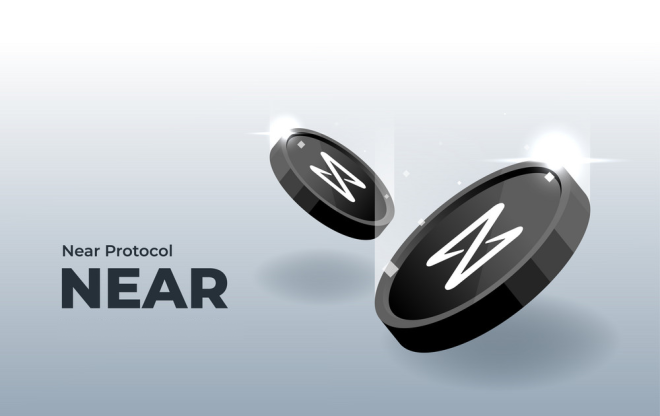
Many will focus on enhancing the three pillars of blockchain technology—security, scalability, and decentralization—when considering the optimization of blockchains. While changes to these blockchain basics may enhance the network’s capabilities, they fall short of enhancing the user experience.
NEAR protocol has already built a solid basis and is 10 years ahead of Ethereum’s timeline, whereas Ethereum recently switched to proof-of-stake (PoS) to work on its fundamentals. NEAR is intended to be quick, safe, and scalable. The blockchain may reach finality in under three seconds and keep transaction costs around $0.01 by using Nightshade sharding. Based on such a solid base, NEAR has been able to concentrate its efforts on developing a user-friendly environment that.
NEAR has continuously supported its user and developer communities and empowered its members to generate enduring, significant initiatives for everybody. Projects like Few and Far have offered a community-first experience that reimagines both creativity and community in the read-write-own era of the internet. By continually concentrating its efforts on enhancing its platform for disruptive developers, NEAR has encouraged community-owned initiatives.
Because of its emphasis on innovative developers, NEAR has grown to be a major player in the decentralized applications market (dapps). As a result, there are now more options for what may be done on the platform, further differentiating NEAR from its rivals. The emphasis on simplifying the development experience that NEAR has over other blockchain protocols is one of the greatest distinctions. Differences in programming languages and development methodologies might prove to be substantial entrance barriers for Web2 engineers trying to launch their careers in Web3. The development process must be open to anyone for the next generation of Web3 apps to challenge Web2 institutions.
NEAR makes it simple to create Web3 for the public since it was created by developers, for developers. Building on NEAR has established a setting where developers may concentrate more on their product and less on syntax thanks to clear documentation and a vast collection of developer tools. Most importantly, NEAR enables programmers to create projects in the languages they adore. The protocol has added support for JavaScript-based smart contracts, giving Web2 developers a more comfortable coding environment. As an alternative, you may create smart contracts using Rust, a high-performance programming language that developers on Stack Overflow chose as their favorite.
Projects on NEAR have continued to advance their capacity for adoption by building on a robust, inclusive environment. Octopus Network, a multichain, interoperable network offering the foundation for substrate-based and EVM compliant app chains, is an excellent example of a project advancing the scalability of NEAR. With Octopus Network, there are more options than ever for launching your project on NEAR, achieving Polkadot interoperability, and establishing your community.
The protocol has developed an ecosystem of disruptive Web3 initiatives trying to take on Web3 head-on by improving the development experience and assisting those wishing to build atop NEAR. Consider Niche, for instance. Niche is a Web3 social app made for users, not ad revenue producers, and was created by former Web2 social executives at Facebook, Tinder, and Bumble. The platform really establishes an environment for content producers, collectors, and hobbyist groups to forge deeper connections across communities by swapping the Web2 paradigm of data harvesting and ad sales for a Web3 user-owned data model.
Another innovative initiative with an NEAR foundation, SeatlabNFT aims to overtake a significant market leader. By removing fraud and lessening the effects of scale, SeatlabNFT is an NFT event ticketing marketplace that aids artists in building stronger relationships with their followers. Platforms like Ticketmaster have all too frequently exploited artists and their followers in order to make money. This was made very clear by the recent Taylor Swift Eras tour sale, in which tickets that were originally $49 rose to almost $22,000. Through NFT tickets, SeatlabNFT enables artists—rather than scalpers—to profit from secondary sales and strengthens their relationship with fans.
Another sector that the NEAR ecosystem is poised to upend is the gaming sector. There are approximately 3 billion active video game customers globally, according to the most recent global video gaming research from DFC Intelligence. To put it another way, active gamers make up close to 40% of the global population. Only about 0.04% of all gamers worldwide, or 1.1 million UAWs, participated in blockchain-based gaming in Q2. Gaming has enormous potential for change, and NEAR is prepared to take advantage of this chance.
To transition Web2 players in large numbers to Web3, PlayEmber is an X-chain GameFi infrastructure. PlayEmber provides gaming developers with a Unity-based SDK that can be swiftly integrated into initiatives aiming to transition towards Web3 by utilizing the agility of NEAR. With the help of this SDK, games may interact with players more effectively by providing special incentives, awards for loyalty, and other distinctive features. PlayEmber’s redistributed ad income model, which enables players to redeem their community donations right on the platform, makes all of this feasible.
The initiatives being built on NEAR right now that aim to innovate on Web2 firms’ failures may be some of the most disruptive ones ever. To advance the creative economy, initiatives like More Than Us, for instance, are nurturing some of the most powerful networks and collectives. NEAR-based initiatives have the capacity to ensure that no user is excluded, in contrast to Web2 projects that frequently erect barriers for certain users. In order to help underprivileged populations into the Web3 realm, More Than Us empowers and supports them. By supporting Web3’s user-owned ethos, NEAR protocol has developed an ecosystem that is ideal for innovative developers.
A source: https://www.coindesk.com/
